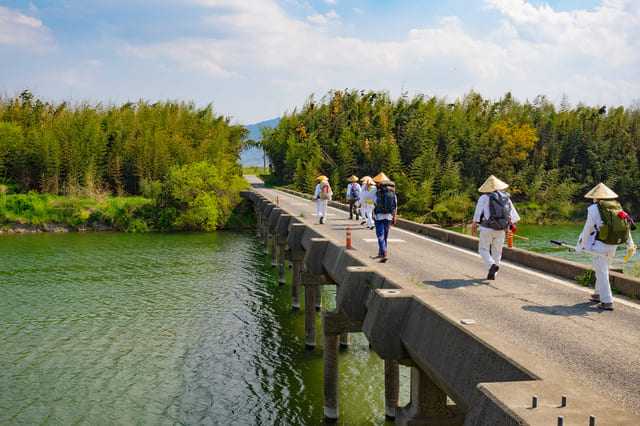Empower and Revitalize Japan for Next Generation
Enjoy our initiatives and ideas that embody SOPHOLA's Vision, Mission and Values.
We will update our employees' daily lives and thoughts so that you can understand the SOPHOLA culture.
Regions Recommended for Foreign Visitors on Their Second Visit to Japan (Part 3)
Since the previous interlude on Okinawa and Kyushu was well-received, I’d like to feature the final installment on Shikoku this time. Although I have not yet visited Shikoku myself, it is a wonderful region with abundant nature, unique culture, and numerous attractions. I will introduce some of its highlights here.
3. Shikoku
When you think of Shikoku, the famous pilgrimage of the “Shikoku 88 Temple Pilgrimage” likely comes to mind. This pilgrimage involves visiting 88 temples associated with Kobo Daishi (Kukai). The journey is known to be physically and mentally demanding but is believed to cleanse worldly desires and bring blessings. Here, I’ll introduce the characteristics of each prefecture. (Reference: What is the Shikoku 88 Temple Pilgrimage? Explanation of what to prepare and how to make the pilgrimage for the first time).

Tokushima Prefecture – “The Place of Spiritual Awakening”
Tokushima Prefecture has temples 1 to 23. This is the starting point of the pilgrimage, known as the “Place of Spiritual Awakening.” At the first temple, Ryozenji, you can purchase a pilgrim’s set, and the distances between temples 1 and 11 are short enough to visit several in a day. However, the path to temple 12 includes a steep slope known as “Henro Korogashi.”
Kochi Prefecture – “The Place of Ascetic Training”
Kochi Prefecture has temples 24 to 39. Being the largest prefecture in Shikoku, it presents a rigorous challenge for pilgrims, akin to ascetic training. The distance between temples 24 and 38 is about 90 km, making it a long journey for walking pilgrims.
Ehime Prefecture – “The Place of Enlightenment”
Ehime Prefecture houses temples 40 to 65. This area is known as the “Place of Enlightenment,” where worldly desires are severed, and the mind becomes serene. Many temples are situated in the mountains, offering a sacred atmosphere amidst nature. It includes Ishiteji near the tourist spot Dogo Onsen.
Kagawa Prefecture – “The Place of Nirvana”
Kagawa Prefecture includes temples 66 to 88. As the smallest prefecture in Shikoku, the distances between temples are short. Pilgrimage here concludes at the final temple, Okuboji, which has the “Shikoku Pilgrimage Completion Gate” inscribed with “Shikoku Sacred Place Completion.”
The Shikoku 88 Temple Pilgrimage offers unique attractions and challenges in each prefecture, fostering spiritual growth through the journey.
Each prefecture within Shikoku has its own distinct charm. For example, Kochi Prefecture is home to the beautiful Shimanto River, known as Japan’s last clear stream.(Reference: Activity-packed! Refresh yourself with the clear streams of Shimanto River and Niyodo River)

Shimanto River
The Shimanto River flows in western Kochi Prefecture and stretches about 196 km. Here are some of its attractions:
1. Clear Water: Known for its pristine clear stream, the Shimanto River boasts high transparency and beautiful scenery. Its water quality is symbolic of the river itself.
2. Diverse Nature: Along the river, lush nature unfolds, offering scenic views throughout the seasons. Cherry blossoms in spring, fresh greenery in summer, autumn leaves, and snowy landscapes in winter can all be enjoyed.
3. Recreational Activities: The Shimanto River offers a variety of outdoor activities such as canoeing, kayaking, and fishing. River rafting by canoe is particularly popular, with courses available for beginners to advanced paddlers.
4. Traditional Culture: The area around the Shimanto River retains traditional fishing methods and cultural practices. Activities such as “Ukai” (cormorant fishing) and “traditional raft floating” are part of the historical cultural experiences available.
5. Local Cuisine: Dishes featuring river fish, Shimanto pork, and fresh local vegetables are a highlight. Grilled sweetfish and eel dishes are particularly popular among visitors.
6. Hot Springs and Accommodation: Along the river, there are hot spring resorts and charming accommodations where you can relax and enjoy a leisurely time in nature. These spots are perfect for those seeking relaxation.
The Shimanto River is cherished by many for its beautiful nature, rich culture, and diverse activities. A visit here offers a wonderful opportunity to experience the natural and cultural beauty of the region.
This concludes our series, highlighting that Japan is a country with many unique and charming regions beyond Tokyo, Kyoto, and Osaka. We hope that international visitors who come to Japan for the second time and beyond will explore these various attractions as well.
Masaki “Mark” Iino
Founder & CEO
SOPHOLA, Inc
